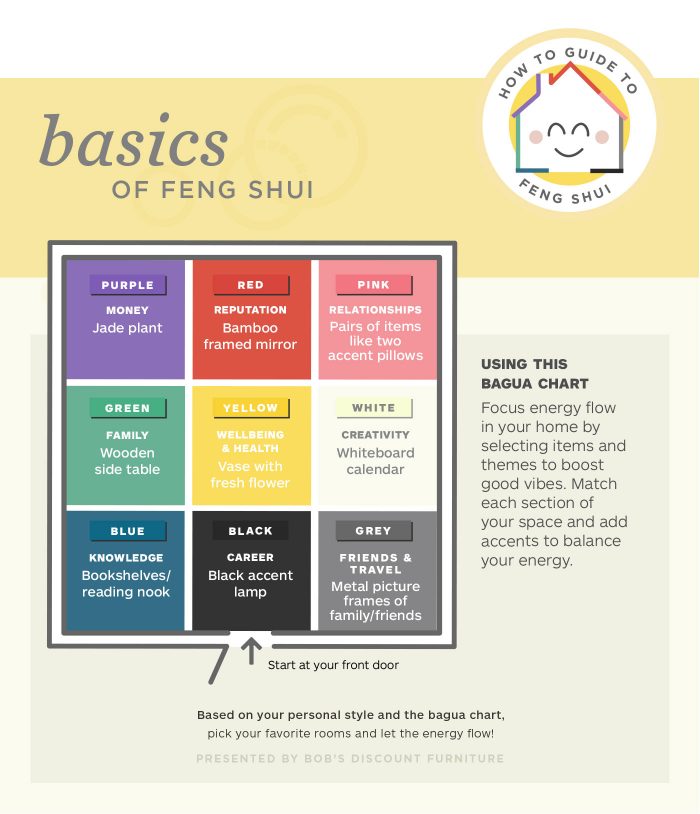Feng Shui: What’s It Good For Anyway? Balance Energy At Home To Improve Wellness
Health and wellness is most commonly obtained through a sound mind, body, and soul. But what about home?
Recent findings have determined that environmental stress can have a huge impact on our overall health and wellness levels. Environmental stress is best defined as the way both people and animals respond to physical, chemical, and biological qualities in environments.
There are several categories included in environmental stressors. They include major disturbances, climate changes, anthropogenic influences, and biological stressors. Luckily, many of us are not impacted by natural disasters or ionizing radiation on a daily occurrence. Perhaps most impactful however, are our immediate surroundings.
Physical environment stressors are comprised of too much or not enough light, colors, and the location of items in your home. This is where feng shui comes in.
Feng shui is an ancient Chinese art of placement that claims the arrangement of furniture, objects and accents directly correlates with the energy, or ‘chi’, of a specific place. In life, there are several spheres that create human existence and each is affected by positive or negative chi.
The Five Feng Shui Elements: these elements further enhance your space’s ability to have better chi; each element has important colors, textures, artwork, shapes, and furnishings to consider.
- Earth – promotes stability and nourishment; square shapes; earthy tones like yellow, tan and brown
- Fire – aids in passion, emotions and finding your inner light; triangle shapes; fiery shades like red, orange and pink
- Metal – encourages certainty and focus; round shapes; pure colors like white and gray
- Water – fosters communication and self-reflection; meandering, fluid shapes; oceanic blue hues
- Wood – benefits growth, new beginnings and prosperity; columnar, vertical shapes; energizing green colors
Yin and Yang: this theory represents two deeply intertwined life forces; the yin signifies feminine attributes while the yang connects to masculine energy; both the yin and yang are necessary in life to create harmonious living.
- Yin Energy – passive energy; main focus of relaxation; most applicable in bedrooms and bathrooms; implemented through calming colors, soft music, and the water element.
- Yang Energy – active energy; most useful in the home office, kitchen, and front entryway; expressed with vibrant sounds, colors, and tall plants.
After reviewing some common basic principles, it’s time to get that energy flowing. Believe it or not, feng shui is as easy as starting at your front door.
The color of your front door is not the only factor that plays a part in feng shui. When using a bagua chart, be sure to match each section of your home’s floor plan and then add accents based on color, material, and shape to balance energy.
This is the perfect time to take a personal inventory of what may be lacking in your life. Consider each life realm: wealth, reputation, relationships, family, health, creativity, knowledge, career, and friendships. Are there any areas you’d like to improve?
When considering health and wellness, take a look at the center of the chart. This sphere’s color is yellow, which most corresponds most to the earth element.
The objects that you use to optimize energy are commonly known as “cures” in feng shui. Popular health and wellness cures include objects such as art, mirrors, and an ample use of lighting. Decorate with square shaped accents that create stability as well as other options that promote health and wellness.
Most importantly however, is your connection to the bedroom. In feng shui, health and wellness is closely tied to rejuvenation so start by choosing a mattress that helps with restful sleep. Consider different mattress firmness options, your personal preferences and supportive accessories like throw or body pillows.
There are plenty of other ways to have good feng shui in your bedroom. Specifically in your bedroom though, make sure you have a strong and sturdy headboard free of cutouts or loose frames. Decorate in pairs, choose light art fixtures and only put photos of who’s sleeping in the bedroom throughout the space.
Perhaps most important though, is the way you position your bed. Feng shui has lucky directions based on your kua number that correspond with the different life spheres. Placing your bed in the direction that most attracts health and wellness is a sure fire way to improve and balance this area.
Money, success, health, love, and personal growth are most affected by responding to energy in your lucky direction. Due to the amount of time in our lives we spend sleeping, placing your bed in your specific lucky direction is particularly important.
Hopefully, it is in the commanding position which is diagonal by not directly facing the entrance to a room. Also, it is important to avoid placing your bed under any windows. This is related to a human’s innate instinct for fight or flight — seeing the entirety of a room allows us to truly relax in a space.
Keep in mind that at the end of the day, your space is your home and the best way to create a healthy environment is by staying true to yourself. Make sure you decorate and adorn with pieces that speak to you and evoke tranquility in everyday life. By achieving this, health and wellness is sure to follow.





Read 0 comments and reply